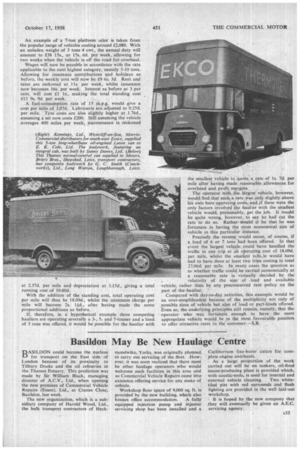It costs so little to protect so much,
Page 82

Page 83

If you've noticed an error in this article please click here to report it so we can fix it.
An example of a 7-ton platform oiler is taken from the popular range of vehicles costing around £2,080. With an unladen weight of 3 tons 4 cwt„ the annual duty will amount to £38 15s., or 15s. 6d, per week, allowing for two weeks when the vehicle is off the road for overhaul.
Wages will now be payable in accordance with the rate applicable to the next highest category, namely 5-10 tons. Allowing for insurance contributions and holidays as before, the weekly cost will now be £9 6s. 3d. Rent and rates are reckoned at lls, per week, whilst insurance now becomes 16s. per week. Interest as before at 3 per cent. will Cost £1 IS., making the total standing cost 112 9s. 9d. per.week.
A fuel-consumption rate of 15 m.p.g. would give a cost per Mile of 3.07d. Lubricants are adjusted to 0.25d. per mile. Tyre. costs are also slightly higher at 1.76d., assuming a set now costs £200. Still assuming the vehicle averages 400 miles per week, maintenance is reckoned
at 2.37d. per mile and depreciation at 3.15d., giving a total running cost of 10.60d.
With the addition of the standing cost, total operating cost per mile will thus be 18.09d., whilst the minimum charge per mile will become 2s. lad., after having made the same proportional additions as before.
If, therefore, in a hypothetical example three competing hauliers are operating severally a 3-, 5and 7-tonner and a load of 3 tons was offered, it would be possible for the haulier with
the smallest vehicle to quote a. rate of ls. 7d. per mile after having made reasonable allowances for overhead and profit margins.
The operator with the largest vehicle, however, would, find, that such,.a.rate was.only slightly above his on bareloperating costs,-,and If these were the only factors involved the haulier with the smallest vehicle would, presumably, get the job. It would be quite wrong, however, to say he had cut the rate to do so. Rather would it be that he was fortunate in having the most economical size of vehicle in this particular instance.
Precisely the reverse would occur, of course, if a load of 6 or 7 tons had been offered. In that event the largest vehicle could have handled the traffic in one trip at an operating cost of 18.09d. per mile, whilst the smallest vehi.:le would have had to have done at least two trips costing in total 27.06d. per mile, In many cases the question as to whether traffic-could be carried economically at a reasonable rate is virtually decided by the relativity of the size of load and available vehicle, rather than by any preconceived rate -policy on the part of the haulier:
Compared with day-to-day activities, this example would he an over-simplification because of the multiplicity not only of possible Sizes of vehicle but also of load or part-loads offered. Even so, the underlying principles still remain, namely, that the operator who was fortunate. enough. to have, the most appropriate vehicle would be in the most favourable position to offer attractive rateS to the customer.—S,13..




















































































































